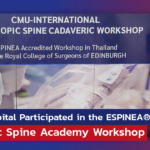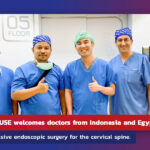FAQ-What to Do after Surgery?
What you should know after waking up from back surgery
-You would regain consciousness with various tubes and cables attached to your body such as the saline drip, urine drainage, blood drainage from the wound, and the machine to monitor vitals.
-You will be asked to undergo an assessment of your nervous system once you regain consciousness such as being asked to flex your feet or toes.
-Patients who do not have to stay in the intensive care unit (ICU) will be moved to the recovery room for 1-2 hours post-surgery to be monitored.
-Patients who need to have their condition monitored closely, such as senior patients, will be advised to stay in the ICU for one night before moving to a normal room.
-Some spinal surgeries may require patients to have to refrain from food and drink for a period of time post-surgery but most patients will be allowed soft food within 24 hours.
-If you are feeling pain around the incision wound, please inform your nurse so pain medication can be administered. The pain should be alleviated in 2-3 days.
-Patients who undergo anesthetic and were intubated can experience sore throat, dryness in the mouth, or nausea post-surgery.
-Patients who were administered local anesthetic along the spinal cord or the nerve may still experience its effect and should be cautious about bumping or having extremely hot or cold items touch the numb area.
-If you have difficulty urinating after the surgery, please inform the physician or nurse as you will need temporary urine drainage.
How many days after the surgery can you get up and walk about?
You should be able to get up and practice walking on the second or third day after the surgery and have your urine and blood drain tubes removed. However, the physician will assess the situation on a case-by-case basis.
When can the wound get wet?
The wound can get wet only when it completely heals which could take around 2 weeks (or 10-14 days). The physician will assess the wound and inform you before you are discharged.
Why does it take longer for some patients’ wounds to heal?
The healing of the wound depends on its size, its depth, its location, as well as the blood flow around the area. Moreover, the overall health of the patient, their age, their diet, and whether they have any chronic illness are also factors which determine how long it would take for the wound to heal. For example, diabetic patients will require longer for their wounds to heal.
Do stitches need to be removed?
Whether stitches need to be removed depends on the type of stitches the surgeon used. Dissolving stitches don’t need to be removed but other types will have to be removed within 10-14 days and the surgeon will inform you accordingly.
How soon do you need to return to the hospital to have your wound assess once you are discharged?
It depends on the surgeon but it is typically about 1 week after surgery.
What are the symptoms in a case when the wound doesn’t heal properly?
If the wound continues to hurt at the same level of intensity for a long period, if there is redness or swelling, if you experience fever, if there is a discharge from the wound, or if there is an abnormal back pain, you should hurry back to see your physician.
How long do you need to wear a back support brace post-surgery?
Some back surgeries require you to wear back support for 1-2 months post-surgery or depending on the physician’s recommendation.
How long do you need to recuperate before being able to return to work?
Most patients feel much better 2-3 weeks after surgery and can return to work. Some may require 4-8 weeks of rest before being able to go back to work. It all depends on the health of the patient, the kind of work they do, and the type of surgery they had.
Post-surgery activities upon returning home for most lower back surgeries
Week 1
-Wear a back or neck brace and walk around the house using a cane every day and as often as possible, increasing the distance and duration a little every day.
-Do not sit for more than 20 minutes.
-Hold on to the railing when walking up or down the stairs.
-Take medication as prescribed by your physician.
-Take care of the wound as advised by your physician.
Week 2
-Increase daily activities and walk farther and more often but rest if you are feeling tired.
-Do not lift objects weighing more than 2 kilograms.
-Patients who have recovered and do not feel any pain can drive far distances. The physician may ask you to return to the hospital to have your condition assessed.
Week 3
-Practice walking by increasing the distance and duration.
-Light household chores are possible.
-You can lift objects not weighing more than 5 kilograms.
-Younger patients will see a faster recovery and may not require a cane when walking anymore but do wear a back support brace as advised by your physician.
Week 4
-You will be able to walk farther and longer.
-You can start on light exercises and take on more household chores.
-You can drive a farther distance.
-You would not need to use a cane anymore but should still wear a back or neck support brace as advised by your physician.
In the second and third month post–surgery, you can increase your activities and take up swimming, stationary cycling, or light exercises. However, you may still feel a tensing of the back up until the third to fifth month post-surgery. These recommendations are for normal back surgeries but some surgeries may require different recommendations and the physician will inform the patient and assess their condition accordingly on a case-by-case basis. Follow your surgeon’s recommendations and meet your physician as scheduled for an assessment of your conditions.
What you should do and avoid post–surgery
Activities to avoid
- Bending over forward or backward
- Bending over to lift an object; always lower your knees to lift something
- Lifting overweight objects
- Staying in areas with a lot of vibration
- Sitting for long durations particularly on a soft cushion which may arch your back. If you need to sit all day for your work, get up and walk around every hour.
Activities to do
- Exercise by walking and increasing the distance every day
- Wear shoes with a cushioned sole to absorb pressure while walking or exercising
- If the wound has healed but you still feel a tensing of the back, exercise by swimming to relax and strengthen your muscles
Can you drive long distances?
You can drive long distances once your pain alleviates. Most patients can return behind the wheels 2 weeks post-surgery and can drive longer distances 2-3 months post-surgery. Do avoid driving long distances for a long duration. Take a break and change your posture every 1-2 hours.
What should you do if you need to be in the car or travel long distances?
If you need to be in the car for long-distance travel, adjust the seat backwards to shift your weight to your back and change your posture every now and then.









